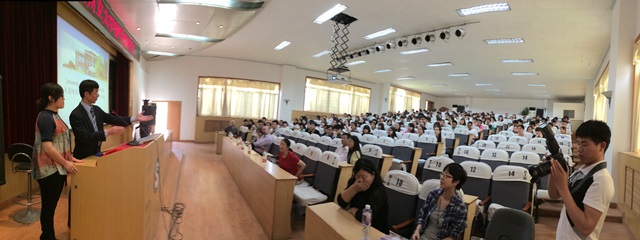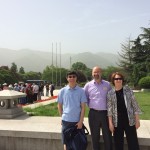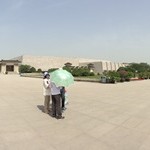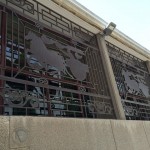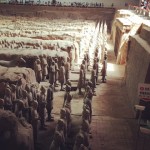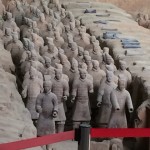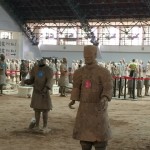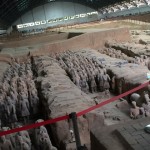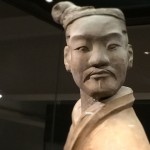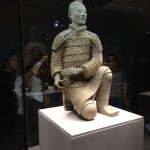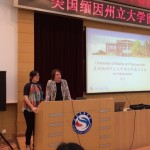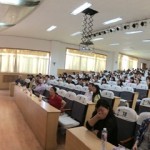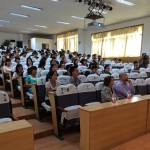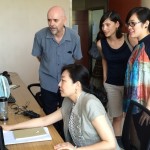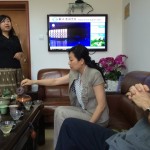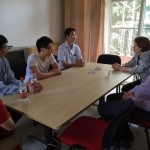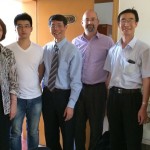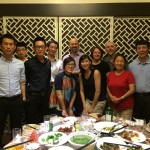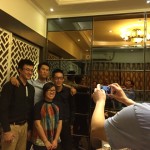To balance our full meeting schedule in the afternoon, our Siyuan hosts suggested a visit to the Mausoleum of the First Qin Emperor in the morning. We knew the Terra Cotta Warriors displayed there were much bigger than the ones we’d seen the day before, but we weren’t prepared for the size of the excavation and how extensive the grounds were. We were greeted at the gate by a two-story tall emperor and then passed tour busses laden with passengers on our way to our drop-off point. Our wait for tickets gave us the opportunity to people-watch, and we were again struck by the wide-ranging fashion (did we mention the women climbing the Great Wall in high heels? Or the crazy outfits we’ve seen on the streets of Beijing?). Couldn’t help but snap one picture of an especially unique T-shirt.
After a few group photos outside the Mausoleum, we descended into the first pit. The Eighth Wonder of the World did not disappoint.  Hundreds of Terra Cotta Warriors were lined up in long rows in an area that was much bigger than a football field. The level of detail in the warrior’s faces and dress was amazing and the work being done to excavate them was extensive. In fact, the excavation has been underway for about 40 years now. We had a chance to see some of the restoration process in action and couldn’t help but be impressed as a group of Chinese restorers stood around a partially reconstructed warrior and tried to figure out where one particular piece of terra cotta needed to be fit back in, like a puzzle.
Hundreds of Terra Cotta Warriors were lined up in long rows in an area that was much bigger than a football field. The level of detail in the warrior’s faces and dress was amazing and the work being done to excavate them was extensive. In fact, the excavation has been underway for about 40 years now. We had a chance to see some of the restoration process in action and couldn’t help but be impressed as a group of Chinese restorers stood around a partially reconstructed warrior and tried to figure out where one particular piece of terra cotta needed to be fit back in, like a puzzle.
Pit 2 gave us a chance to see more excavation work underway and view replicas of some of the warriors up close. Archers and high officials stood behind glass, and being able to get that close gave us the opportunity to see just how detailed the artists who’d crafted them had been. You could see individual hairs on their heads and detailing on their armor. Considering the thousands of warriors that had to be created for this burial ground, that level of detail in each statue was almost inconceivable.
The third building we entered touted the fact that the place we were visiting was a UNESCO World Heritage site and provided us with a close-up look at some of the many other items that had been buried there (everything from acrobats to entertain the emperor to water pots to exotic birds, in materials from clay to bronze). The building also included more details about the excavation process—we’re sure many people leave that space thinking how amazing it would be to serve as an archaeologist working at this site.
Our way back to the parking lot ended up being a much longer walk than we thought, with more buildings along the way that we didn’t have the time to visit as well as shops offering jade bracelets and food booths selling all kinds of local treats. We made a brief detour to an obviously-for-tourists booth that gave visitors a chance to “dress up” like the Terra Cotta Warriors, which provided us with some of the funniest photos of our trip.

After a quick lunch, we were back at Siyuan for several more meetings. We were delighted to meet up with Sha Liu, one of our graduates, who is now working toward her MBA at Johnson & Wales and was home in Xi’an for a visit.  Our first meeting of the afternoon: a chance to give a presentation about UMPI to a crowd of about 200 Siyuan students. Director Zhou provided introductions and shared with the students our Chinese names. (Don’t think we’d mentioned those yet, but Dr. Lu gave the President, Tom, Ray and Rachel Chinese names—just ask us to present our business cards to you as we pronounce those names in Chinese.) Sha provided the translation as President Schott
Our first meeting of the afternoon: a chance to give a presentation about UMPI to a crowd of about 200 Siyuan students. Director Zhou provided introductions and shared with the students our Chinese names. (Don’t think we’d mentioned those yet, but Dr. Lu gave the President, Tom, Ray and Rachel Chinese names—just ask us to present our business cards to you as we pronounce those names in Chinese.) Sha provided the translation as President Schott delivered the official UMPI welcome and then Dr. Lu and Huidu offered a powerpoint presentation. We’re very hopeful that this will lead to several student inquiries and, while many students seemed most excited about the American chocolate that was offered at the end of the presentation as small gifts, several students stayed afterward to ask more questions.
delivered the official UMPI welcome and then Dr. Lu and Huidu offered a powerpoint presentation. We’re very hopeful that this will lead to several student inquiries and, while many students seemed most excited about the American chocolate that was offered at the end of the presentation as small gifts, several students stayed afterward to ask more questions.
While this presentation was underway, Rachel and Tom had a chance to meet with the marketing/public relations director for the university. With translation help from Sha, she took us on a tour of her area, which included a whole floor of offices focused on everything from graphic design to videography to overseeing the university’s television station and call center. We then returned to her office for green tea (we were alarmed when she “primed” her tea pot by pouring hot water into it and then dumping it straight onto the table, until we realized that the table was a specially designed “tea table” with a drain in it) and discussions about promotion efforts, social media, internet marketing and how we hope to work together on materials to encourage Siyuan students to attend UMPI, once an agreement is reached.
Next on the agenda was an interview with a Chinese high school student connected with Phoenix who will be attending UMPI in the fall. He and his father had traveled about 8 hours to meet with us. It was a chance to allay some of the father’s concerns about sending his son halfway around the world and to meet with some of the people representing the U.S. university where his son plans to spend the next four years. President Schott was able to share, as she had with several parents already, that the student would be safe and comfortable on our campus, that he’d be in a beautiful place with clean air and water, and that we’d take good care of him.
We were also able to meet with a past and future visiting scholar. A few years ago, UMPI hosted a Siyuan professor on our campus for several months as she conducted research and helped to develop more connections between our institutions. It was good to reconnect with her and also meet the new visiting scholar—her focus is early childhood education—who will travel to UMPI in September and join us for the fall semester.
Our day done at Siyuan, we were on our own for dinner and invited the Chinese high school student and his father to join us at a local restaurant with Sha and three of our other alums for yet another feast. With no official transportation, though, we had our first experience hailing and riding in taxicabs (yikes!)—we had to take three separate cabs to get everyone from the hotel to the restaurant. From what we could tell, seat belts weren’t installed and then we were a little nervous when we couldn’t find the restaurant at the spot where we’d been dropped off. Still, all three groups eventually found each other, and the restaurant our alums had chosen.
After we were seated in our private dining room, Dr. Lu led the selection of several sumptuous-looking items from the menu. Our meal started off with watermelon the father of our soon-to-be UMPI student had picked up on the way to the restaurant in honor of the occasion, and then dish after dish came through the door. There was more gan bei-ing, the majority connected with our alums and our new student. A note: when you order white wine in China, you will not get Chardonnay, but instead will be served the much more potent wheat-based liquor that was presented at several of our other special dinners.
During our meal, the Lu’s presented our alums with special gifts from UMPI (lovely pen sets from the Campus Store) and they caught us up on what they’ve been doing post-graduation (going to grad school, working for a tech company, snagging a position at BMW). Obviously, we were bursting with pride to hear about our alums’ accomplishments and hope we’ll have a chance to repeat this with future alums from China.
To work off all those calories from dinner, we opted for the 20 or so minute walk back to the hotel. What we failed to consider, however, is that walking would give us yet another first-time experience in Beijing—surviving road construction and crazy traffic as pedestrians. It was probably the moment when we had to squeeze single file past a bulldozer on one side and traffic careening around the bend on the other that we questioned whether walking had *really* been such a good idea after all.
We were very relieved when we all made it back to the hotel in one piece. And with only one full day left in China, it was off to bed for us.

